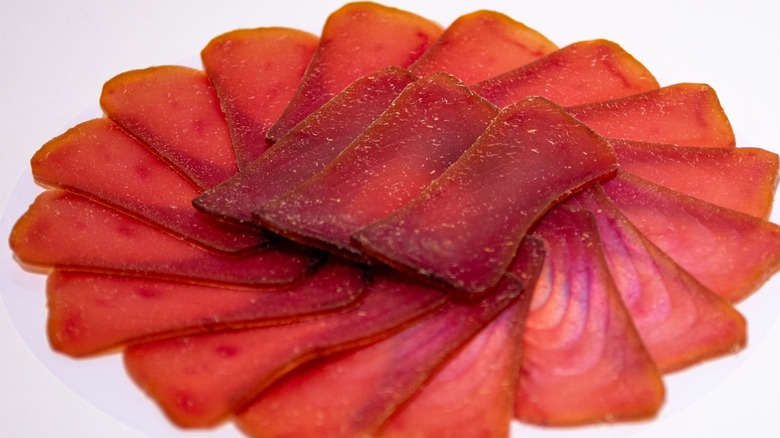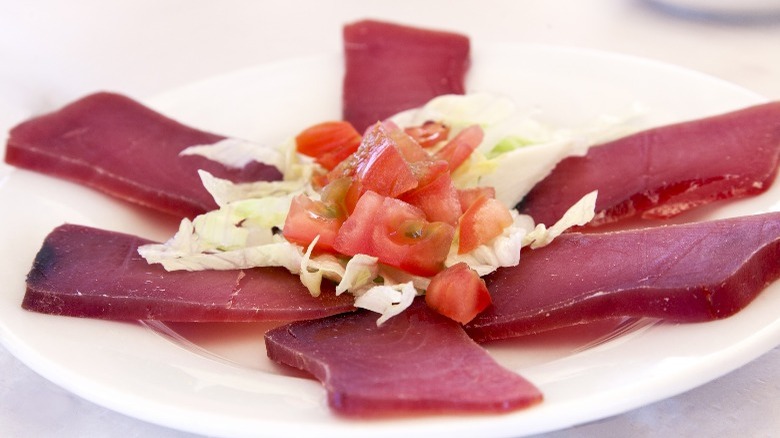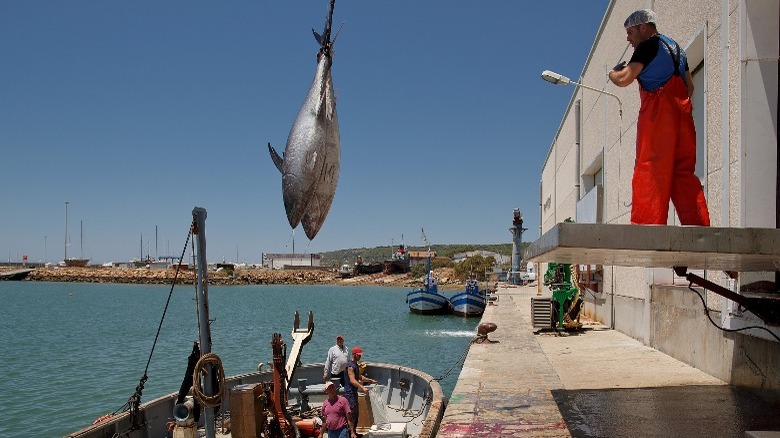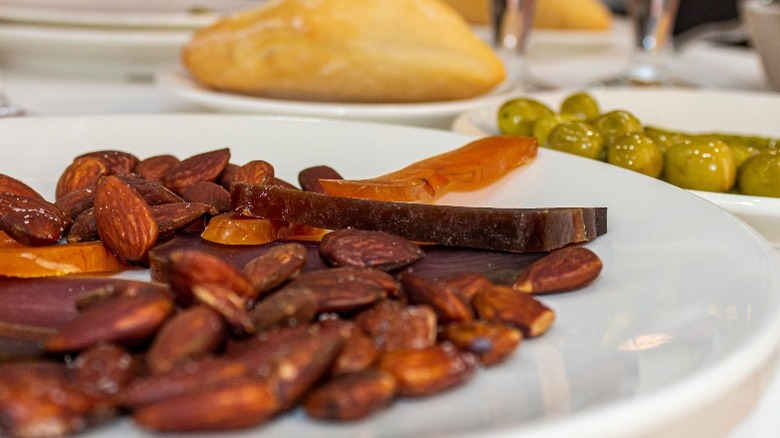Mojama: The Spanish Dried Tuna You Should Know
If you've ever traveled to Spain, or simply stepped foot in a Spanish restaurant, then you may be familiar with tapas, the Spanish style of serving small portions of food, as explained by GoGoEspana. It's a great way to sample a lot of tasty, traditional Spanish dishes and to steady yourself in that "sweet spot" when out for a night of drinking.
According to The Daily Meal, tapas have evolved over the nearly 800 years they've been around. The sheer number and types of items offered have expanded over the years and even been elevated beyond traditional easy-to-prepare staples like sliced bread, cured meats (like Jamón Iberico), and Manchego cheese that once "topped," (tapa means to "top" or "cover") the wine glasses of bar patrons to keep out flies. The Daily Meal reports that tapas falls into three categories: pinchos, montaditos, and general tapas.
One thing that hasn't changed is that tapas dishes are salty by design, a way for bar owners to offer something for patrons to get them to drink more and for longer. Oversalted patrons drink more to quench their thirst (without over-imbibing too quickly) and bar owners reap the rewards, as per Culture Trip. This symbiosis is a kind of delicious balancing act that has made tapas popular not only in Spain but all over the world. And mojama is a part of that rich history.
What is mojama?
Deeply salted and richly flavored, mojama (pronounced mo·ha·ma) is a favorite on any tapas menu. But it's not as ubiquitous as jamón, cheese, olives, croquetas, calamares fritos, or garlic prawns and you won't find it everywhere in Spain. It's a favorite in the south of Spain, where they've been making it the same way for centuries, as per Epicurious. This lean tuna undergoes a traditional curing process that leaves it with a complex salty umami flavor that so rivals ibérico ham that it has been nicknamed, "the jamón of the sea."
According to Atlas Obscura, this lush loin of tuna is often paired with chopped tomatoes and almonds. But the heady, briny intensity of mojama (as well as its hefty price) also lends itself to subtler applications — especially when used sparingly. Mojama invigorates simpler fare with a sumptuous grating of its dry-cured, sangria-tinged-flesh. Try it dusted over blank-canvas staples like eggs, pasta, tomato or avocado toasts, and salads, suggests Feast Magazine).
The delicious history of mojama
Called "Mojama de Atun," "tuna jerky," and "prosciutto of the sea," this salt and sea-air-cured tuna dish dates all the way back to the Phoenicians, who founded the southwestern city of Cádiz (then called Gadir) around 800 BC, as reported by Spain Then and Now. The word "mojama" is derived from the Arabic word "musama," meaning "dry," as explained by Italco Food Products.
The Phoenicians developed a way to catch tuna as it migrated from the chilly Atlantic to spawn in the warmer waters of the Mediterranean in the spring, called "almadraba." According to the travel site Epicurean Ways, this ancient technique (practiced for over 3000 thousand years) uses nets attached to outposts on both sides of the Strait of Gibraltar, capturing fish as they enter. The almadraba fishing tradition continues today with modern restrictions to avoid overfishing and help protect tuna populations.
The Phoenicians were among the most prolific Mediterranean traders from 1,500 to 600 BC (via Spain Then and Now). They developed a way to preserve their fishing bounty for trade with other regions using a combination of salt, sun, and sea air. Home to Phoenicians, Carthaginians, Romans, and Moors, before the Christian Spanish took hold under King Alfonso X of Castile, these Phoenician traditions for fishing and curing mojama in the Andalusian province of Cádiz have been preserved despite time, conflict, and cultural shifts, reports Spain Inside.
How is mojama made?
Mojama de Atun is made through an ancient curing process using a 2000-year-old recipe developed by the Phoenicians (the Portuguese have a similar dish called Muxama de atum). This Spanish delicacy is made using the meat from the tuna loin, which is filleted into long strips, washed, and packed in salt for two days, before being rinsed and laid out to dry in the sun and sea air for the next 20 days or so.
This is a similar process to another tapas favorite, Jamón Iberico, which mojama frequently draws comparisons to, though the Iberico ham can take two to four years to cure, as per Jamon. Both are packed with savory, salty umami flavor — which means a little goes a long way. That mojama packs a punch in the flavor department is a plus, as it's more affordable to enjoy it out at a tapas restaurant or bar than procuring a block for yourself at home. If you do plan to get your hands on some mojama and you're not taking a trip to Spain anytime soon (where it's readily available), you can try your luck at ordering it online in vacuum-sealed pouches from a variety of Spanish purveyors like Spanish Pig, Despana, and Dona Maria and even on Amazon.
How to eat mojama
Produced in Almería, Cádiz, Huelva, Valencia, and Murcia, mojama's intense flavor and firm, leathery texture are best served like Iberico ham — on its own, with just a drizzle of high-quality olive oil. You can enjoy it, paired casually with a beer, or explore the joys of elevating your mojama tastebuds with a glass of light and floral Manzanilla (fino sherry).
If you must do more, be content to let the specialty dish shine and only allow your mojama to share space with simple fare; take care not to introduce overpowering or competing flavor profiles. Try a handful of Marcona almonds, crispy slices of baguette smeared with garlic and tomatoes, a wedge of zesty manchego cheese, or a deft grating of it sprinkled over perfectly soft-cooked scrambled eggs. Remember, whatever you do with mojama, it's the tuna and the salty sea air it's been bathed and dried in that are the real stars here.




